Which Poynting Antenna is Best for Your IoT
Which Antenna Do I Use with My IoT Router?
Choosing between an omni-directional and directional antenna isn't always straightforward. Each has specific strengths depending on your location, connectivity goals, and application. In this article, we explain the key differences to help you select the right antenna for your IoT router—whether you're deploying smart meters in a city or monitoring assets in a remote rural area.
Take advantage of our system design and installation services. Learn more or call us for a free consultation: 1-800-969-8189.
Understanding Omni and Directional Antennas
The simplest way to think about the difference is in how the antennas receive cellular signals.
- A directional antenna focuses its signal reception in one specific direction – similar to a flashlight beam. This allows for greater range and precise targeting. A good example is the LPDA-92 high-gain directional antenna. It supports 698-3800 MHz and offers up to 5 miles of range. Covering LTE, 4G, 5G, CBRS, and 2.4 GHz WiFi, it's ideal for cellular, IoT, and WiFi applications.
- An omni-directional antenna captures signals from all directions, like a light bulb illuminating an entire room, making it more flexible but with less range than a directional antenna. The Omni-293, for example, is great for M2M & IoT applications with support for 617-6000 MHz at 8 dBi max gain.
Both have their place in IoT, depending on the scenario. Let's explore.

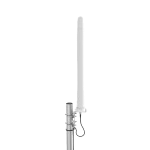
Omni-Directional Antennas: Stability in Every Direction
✔ Best for: Urban/suburban environments, mobile or moving equipment, and installations with changing signal sources.
Key Benefits:
- Multi-directional signal reception: Your IoT router can automatically connect to the best nearby mobile tower. If one tower is down or congested, the router can quickly switch to another.
- Stable in dynamic environments: Ideal for moving applications like autonomous vehicles in warehouses or delivery trucks.
- Simpler installation: No need to align with a specific tower. This reduces installation costs and eliminates callouts for realignment.
- No manual maintenance: If a network provider adds new towers or changes coverage, an omni antenna will adapt automatically.
Limitations:
- Lower gain and peak throughput: Compared to directional antennas, Omni antennas provide lower gain. This is usually acceptable for IoT use, where data packets are small.
- More interference in high-noise areas: Because it picks up signals from every direction, an omni may also receive more interference. This can reduce performance in RF-noisy environments like city centers.
Example Use Case:
A freezer truck equipped with an LTE-M, NB-IoT, or LTE/5G enabled Teltonika router or gateway and a Poynting omni antenna maintains connectivity across regions—no alignment needed.
LTE-M and NB-IoT are wireless IoT technologies made available by mobile network operators across the world through their cellular towers. These wireless technologies were developed specifically for IoT applications, meaning low power consumption and small data packets. This means that instead of sensors and trackers sending their readings to a connected gateway, they can send their readings directly to a cell tower via LTE-M or NB-IoT protocols. Of course, many IoT solutions on the market today make use of the regular cellular data services like LTE or 5G directly.
In the example above, using a refrigerated truck with temperature sensors and GPS tracking, an antenna in Poynting's multi-in-one MIMO or Puck transportation antenna ranges covers all the bases. Featuring MIMO Cellular antenna, they support LTE-M, NB-IoT, LTE, and 5G with support for as low as 410MHz, the MIMO and PUCK range will have you covered for most cellular data and IoT applications, regardless of the technology, frequencies, or protocols your solution is based on.

SISO & 2x2 MIMO antenna variations available.
Shop Now: Starting at $41.18Directional Antennas: Focused Power for Long Distances
✔ Best for: Rural deployments, fringe coverage zones, and interference-heavy environments.
Key Benefits:
- Higher gain and range: By focusing the signal in one direction, directional antennas amplify reception from that direction, making them ideal for connecting to faraway towers.
- Reduced interference: Directional reception minimizes unwanted signals from other directions, improving signal-to-noise and carrier-to-interference (C/I) ratios.
- Stronger signal stability: Particularly in remote or interference-heavy areas, this leads to better performance.
Limitations:
- Limited flexibility: If the tower your antenna points to becomes overloaded or goes down, performance drops significantly.
- More complex setup: You must point the antenna toward the strongest tower. This requires testing and might need readjustment over time.
- Less forgiving to network changes: New towers or shifting traffic loads can make a once-optimal direction less effective.
Example Use Case:
A smart agriculture project using LoRa WAN sensors in a rural valley improves connectivity by pointing a Poynting directional antenna toward the only available base station several miles away.
MIMO vs SISO Antennas
The primary objective of MIMO (Multiple-Input and Multiple-Output) is to increase throughput speeds by using multiple antennas for one connection. The Poynting Omni-600 as an example, has two individual antennas housed in one enclosure with two coax cables from the base of the antenna.
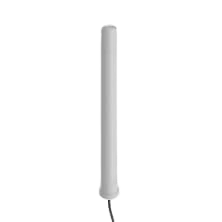
The two most popular technologies that use MIMO are cellular and Wi-Fi. MIMO antennas are ideal for applications that require higher wireless network throughput, such as online gaming, live video feeds and streaming, or when offering WiFi to passengers on a bus. Having an external 2X2 or 4X4 LTE/5G MIMO antenna connected to a supported router ensures you have a stable and fast internet connection.
For Transportation, the Poynting MIMO range of antennas built for vehicles and vessels are great options, offering up to 4X4 MIMO LTE/5G, 2X2 MIMO WiFi, as well as an integrated GPS antenna for real-time remote monitoring and tracking applications.
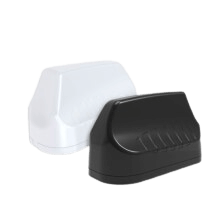
2x2 and 4x4 MIMO omnidirectional antenna options available.
Shop Now: Starting at $195.50Most other wireless protocols require only SISO (Single Input Single Output). Applications such as remote monitoring of sensors require less throughput and bandwidth. The Poynting Omni-2XX series are great examples of high-performing Omni-Directional SISO antennas. While the LPDA-92 is the high-gain uni-directional SISO option.
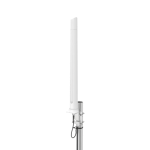
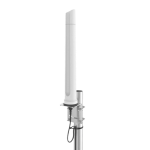

It's worth mentioning that using a MIMO antenna is not a strict requirement for LTE, 5G, and Wi-Fi connections. Cellular routers used in IoT work well with SISO antennas. However, if you need a faster connection speed and throughput then a MIMO antenna will produce faster results.
When to Use Both: Combining Strengths with MIMO
2X2 (two antennas) or 4X4 (four antennas) MIMO LTE and 5G cellular routers, such as those from Teltonika, can use a combination of Omni-Directional and Directional antennas. In a scenario where faster throughput and the most stable and redundant connections are essential, making use of uni-directional antennas to reach a tower situated further from your site, while an Omni-directional antenna reaches towers that are closer, but in different directions, makes for a redundant and stable cellular connection in challenging environments.
To give you an example, using a Teltonika RUTM50, which has four 5G antenna connectors. You could use two LPDA-92 SISO antennas to connect to antenna port 1 and 2, this would provide the reach needed to connect to a faraway cell tower. And then use a 2X2 MIMO Omni-600 on ports 3 and 4. Remember, a 2X2 MIMO antenna is essentially two antennas in one.
In this scenario, all four of the router's antenna connections are receiving 5G signal from various cell towers and aggregates those connections together to achieve a fast, stable connection. If the towers in your immediate radius, which the Omni-600 connects to are disconnected for any reason, the two LPDA-92 will remain connected to the tower that is out of reach of the Omni-600.
And vice versa: If the far away tower (which is out of range for the Omni-600) to which your LPDA-92s are connected to goes down, the Omni-600 remains connected to towers closer to your site, even if they're located in different directions. This creates fast connection speeds when all cell towers are operational, but also redundancy if some of the towers goes down for any reason.
Hybrid Setup Example:
By combining an OMNI-600 and 2 x LPDA-92 antennas you can combine Omni and directional capabilities, making it ideal for complex installations using NB-IoT, LTE, or 5G.
This approach balances the strengths of both antennas:
- Omni elements provide fallback and signal diversity.
- Directional elements improve reach and throughput from the main source.
Summary: Choose the Right Tool for the Job
| Scenario | Best Antenna Type |
| Urban/High Density | Omni-directional |
| Rural/Distant Tower | Directional |
| Mobile or Moving Equipment | Omni-directional |
| High Interference Environments | Directional |
| Variable Network Performance | Omni-directional |
Get the Most Out of Your IoT Setup
The success of any IoT deployment depends on stable and efficient connectivity—and that starts with choosing the right antenna. Whether your focus is signal stability, range, or interference reduction, understanding the differences between omni and directional antennas will help you get the most out of your Teltonika router and your IoT solution.
Need help selecting the best antenna for your IoT setup? Contact us at 1-800-470-6777 or explore our Poynting antennas tailored for IoT applications.
Interested in Learning More? Check Out Our Cellular Info Hub / WiFi Info Hub
Table of Contents

Recent Posts



